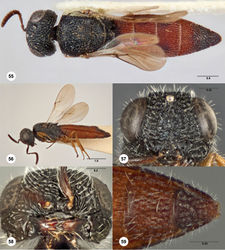Bracalba sparsa
| Notice: | This page is derived from the original publication listed below, whose author(s) should always be credited. Further contributors may edit and improve the content of this page and, consequently, need to be credited as well (see page history). Any assessment of factual correctness requires a careful review of the original article as well as of subsequent contributions.
If you are uncertain whether your planned contribution is correct or not, we suggest that you use the associated discussion page instead of editing the page directly. This page should be cited as follows (rationale):
Citation formats to copy and paste
BibTeX: @article{Burks2012ZooKeys236, RIS/ Endnote: TY - JOUR Wikipedia/ Citizendium: <ref name="Burks2012ZooKeys236">{{Citation See also the citation download page at the journal. |
Ordo: Hymenoptera
Familia: Platygastridae
Genus: Bracalba
Name
Bracalba sparsa Burks sp. n. – Wikispecies link – ZooBank link – Pensoft Profile
Description
Female. Body length 3.37–4.00 mm (n=6). Color of antenna beyond radicle: reddish-brown, darker at scape apex, pedicel, and A3. Radicle color: lighter than scape. Number of claval segments with ventral gustatory sensilla: 7. Number of ventral gustatory sensilla on A6: 1.
Ocular setae: long and sparse. Frontal depression: with irregular rugae indicating large foveae. Smooth depression extending dorsolaterally from antennal foramen: present. Dorsal clypeal margin: forming a complete connection between antennal foramina medially. Clypeal median carina: absent. Ventral clypeal margin: with a small median point. Mandibular color: dark basally and at teeth, becoming lighter reddish brown between these areas. Mandibular teeth: two, separated by narrow incision. Smooth area obliquely posterior to lateral ocellus: present. Genal sculpture: reticulate-rugose without any strong carinae.
Dorsal pronotal area: not set off by carina ventrally. Anterolateral corner of dorsal pronotal area: truncate anteriorly. Sculpture of posteromedian area of mesoscutum: densely foveolate. Lateral margin of dorsal axillar area: with a semicircular expansion, broadest near midlength. Mesoscutellar sculpture: densely foveolate. Metascutellum in dorsal view: trapezoidal but tapering to narrow apex. Dorsal surface of metascutellum: apex protruding dorsally. Femoral depression: crossed by rounded carinae. Leg color: entirely reddish. Anterior corner of lateral propodeal carina: flat, without tooth. Posteromedial corner of lateral propodeal area: protruding posteriorly.
Metasoma color: mostly reddish, variably dark at T4 bend, T5-T6, with variable smaller dark areas elsewhere. Median lobe of T1: with 7 or more longitudinal carinae. Metasoma at middle of T4: with metasomal bend and abrupt transition in sculpture. Posterolateral margins of metasomal terga: with tooth-like protrusions. T5 median carina: absent. Longitudinal sculptural septa on T5: strong, sharply raised. Transverse sculptural septa on T5: weak or absent, much weaker than the longitudinal septa. T5 setae: not directed posteriorly, arising from center of sculptural mesh. T6: as broad or broader than long. T6 laterotergite: overlapping S6. S4 median carina: present. Transverse sculptural septa on S5: weak or absent, much weaker than the longitudinal septa. S5 setae: not directed posteriorly, arising from center of sculptural mesh. Lateral carinae of S6: not meeting apically. Apex of S6: with notch.
Male. Body length 3.5 mm (n=1). Flagellomere length: A3 over 1.5× as long as broad, most others as long or longer than broad. T7: arched and posteriorly concave.
Diagnosis
Female. A6 with 1 large ventral sensillum; 2 mandibular teeth; metascutellum subtrapezoidal but strongly tapering to a narrow truncate apex; metasomal bend expressed as a raised hump with posterior metasomal segments not tilted downwards; sculpture posterior to metasomal hump with strong longitudinal and transverse septa; T4–T6 without longitudinal carina; T6 broader than long; S4–S6 with longitudinal carina; S6 with apical notch.
Etymology
Latin participle meaning “scattered,” recalling the sparsely distributed setae of this species.
Link to distribution map
http://hol.osu.edu/map-full.html?id=302162
Material examined
Holotype, female: AUSTRALIA: WA, Toodyay, 31.X.1979, R. M. Bohart, OSUC 231798 (deposited in WAMP). Paratypes: AUSTRALIA: 4 females, 3 males, OSUC 230821 (ANIC); OSUC 148703, 238204-238206, 238208 (CNCI); OSUC 55870 (OSUC).
Comments
Bracalba sparsa represents a distinctive element within the genus, with its unique metasoma and unusual metascutellum.
Original Description
- Burks, R; Masner, L; Johnson, N; Austin, A; 2012: Taxonomic revision of Bracalba Dodd (Hymenoptera, Platygastridae s.l.), a parasitoid wasp genus endemic to Australia ZooKeys, 236: 1-53. doi
Images
|
